Cross-Cultural Management: A Comparative Analysis of Congo and Norway
VerifiedAdded on 2022/08/26
|20
|4416
|34
Report
AI Summary
This report provides a comprehensive analysis of cross-cultural management, focusing on the comparison between Congo and Norway. It delves into various cultural dimensions, including power distance, individualism, uncertainty avoidance, long-term orientation, and indulgence, using Hofstede's and Trompenaars' models to highlight key differences. The report examines communication styles, decision-making processes, management approaches, and value systems within each country. It further explores how these cultural nuances impact business operations, leadership styles, and team dynamics. The analysis provides a detailed overview of how cultural factors influence various aspects of business, offering valuable insights for navigating international business environments. The report also covers the impact of historical socio-political events on cross-cultural relationships and offers recommendations for effective cross-cultural management strategies.
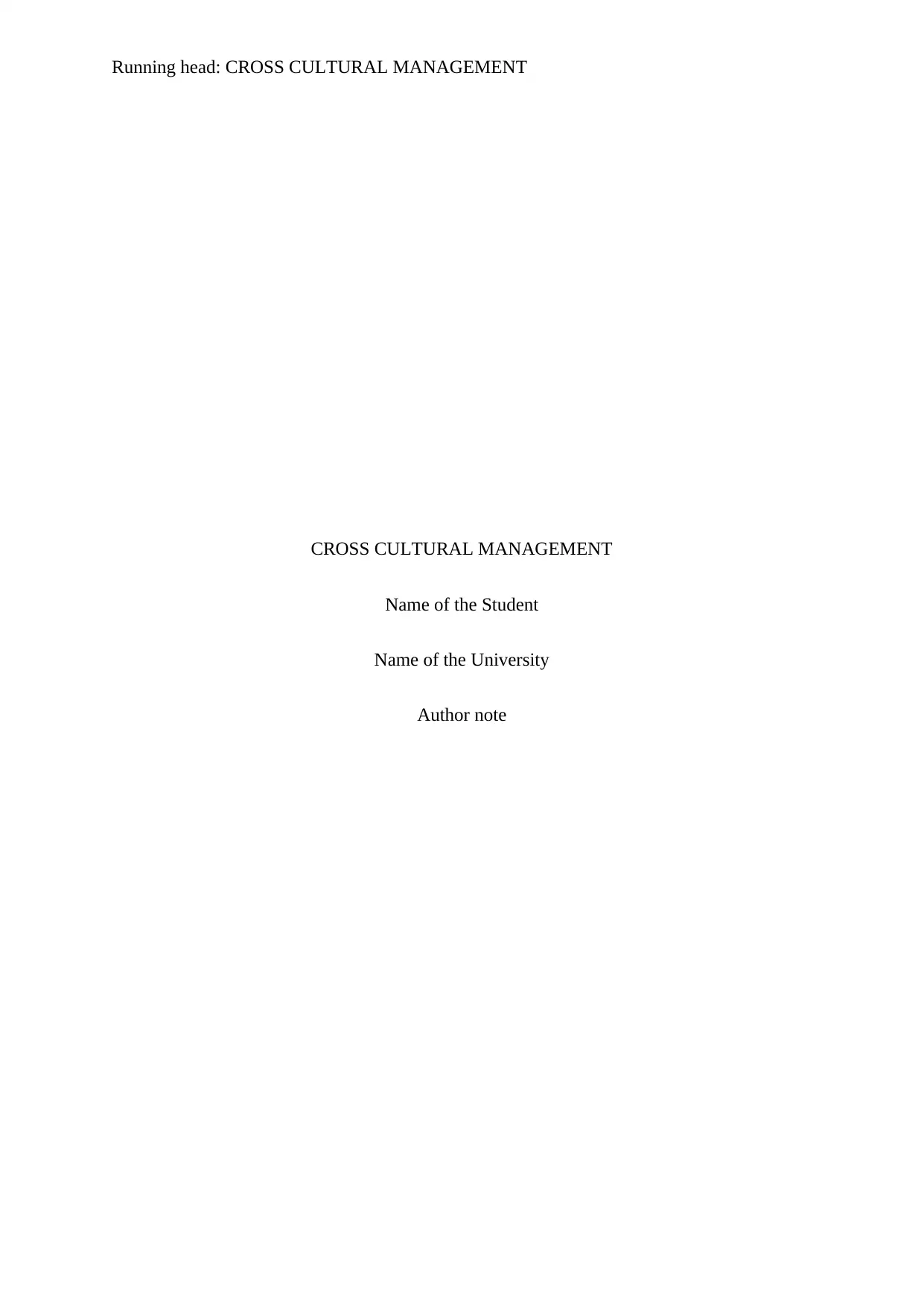
Running head: CROSS CULTURAL MANAGEMENT
CROSS CULTURAL MANAGEMENT
Name of the Student
Name of the University
Author note
CROSS CULTURAL MANAGEMENT
Name of the Student
Name of the University
Author note
Paraphrase This Document
Need a fresh take? Get an instant paraphrase of this document with our AI Paraphraser
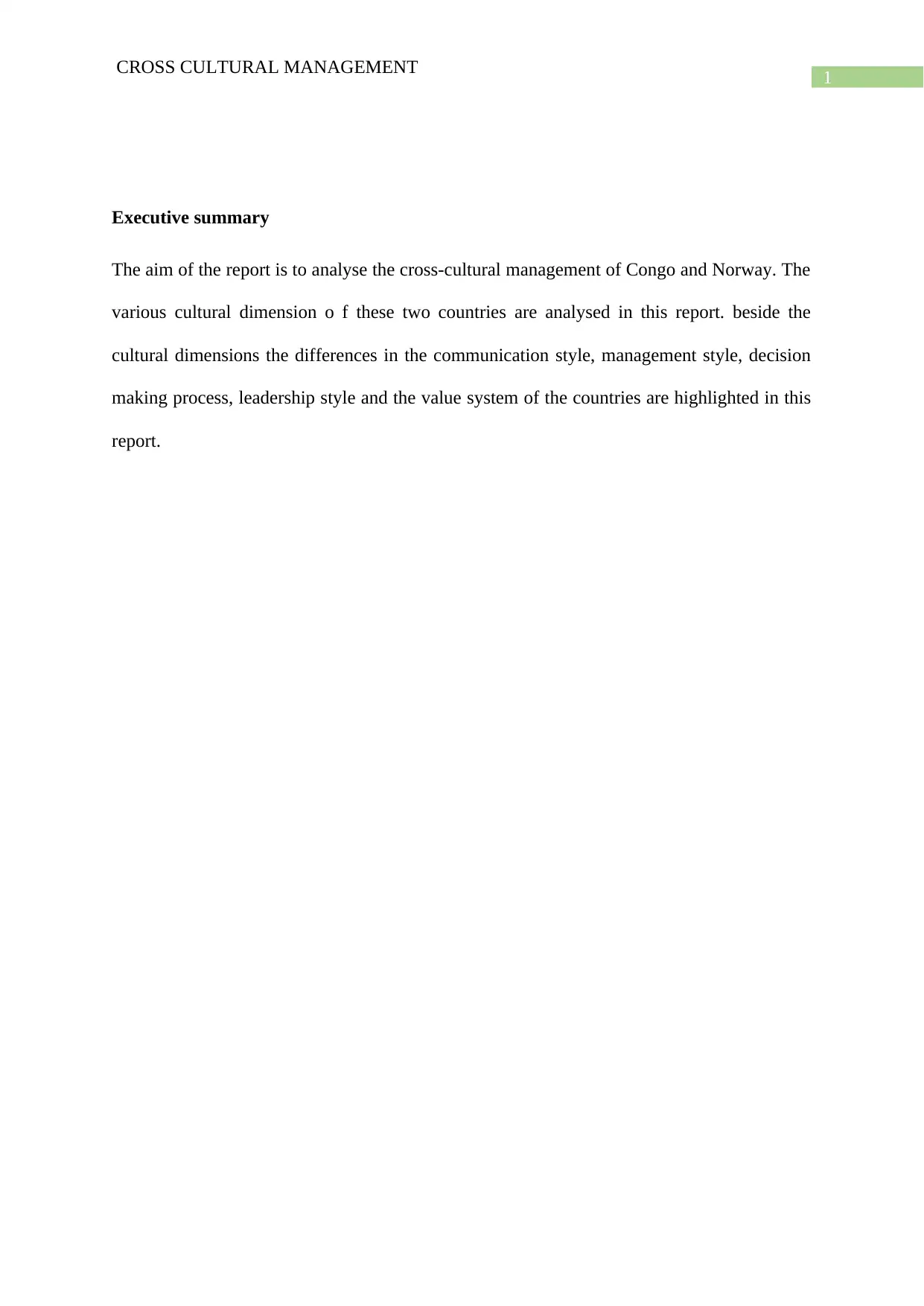
1
CROSS CULTURAL MANAGEMENT
Executive summary
The aim of the report is to analyse the cross-cultural management of Congo and Norway. The
various cultural dimension o f these two countries are analysed in this report. beside the
cultural dimensions the differences in the communication style, management style, decision
making process, leadership style and the value system of the countries are highlighted in this
report.
CROSS CULTURAL MANAGEMENT
Executive summary
The aim of the report is to analyse the cross-cultural management of Congo and Norway. The
various cultural dimension o f these two countries are analysed in this report. beside the
cultural dimensions the differences in the communication style, management style, decision
making process, leadership style and the value system of the countries are highlighted in this
report.
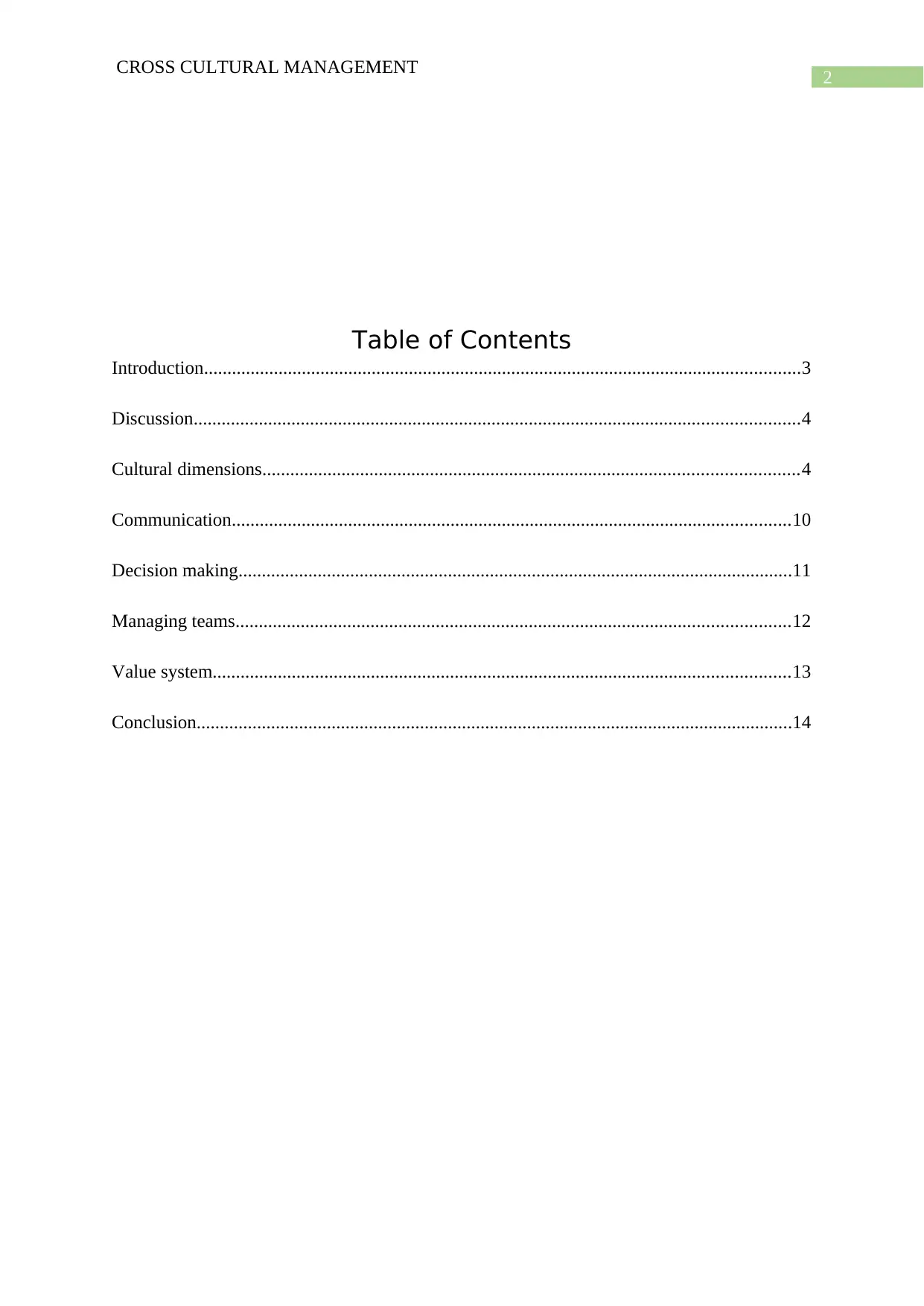
2
CROSS CULTURAL MANAGEMENT
Table of Contents
Introduction................................................................................................................................3
Discussion..................................................................................................................................4
Cultural dimensions...................................................................................................................4
Communication........................................................................................................................10
Decision making.......................................................................................................................11
Managing teams.......................................................................................................................12
Value system............................................................................................................................13
Conclusion................................................................................................................................14
CROSS CULTURAL MANAGEMENT
Table of Contents
Introduction................................................................................................................................3
Discussion..................................................................................................................................4
Cultural dimensions...................................................................................................................4
Communication........................................................................................................................10
Decision making.......................................................................................................................11
Managing teams.......................................................................................................................12
Value system............................................................................................................................13
Conclusion................................................................................................................................14
⊘ This is a preview!⊘
Do you want full access?
Subscribe today to unlock all pages.

Trusted by 1+ million students worldwide
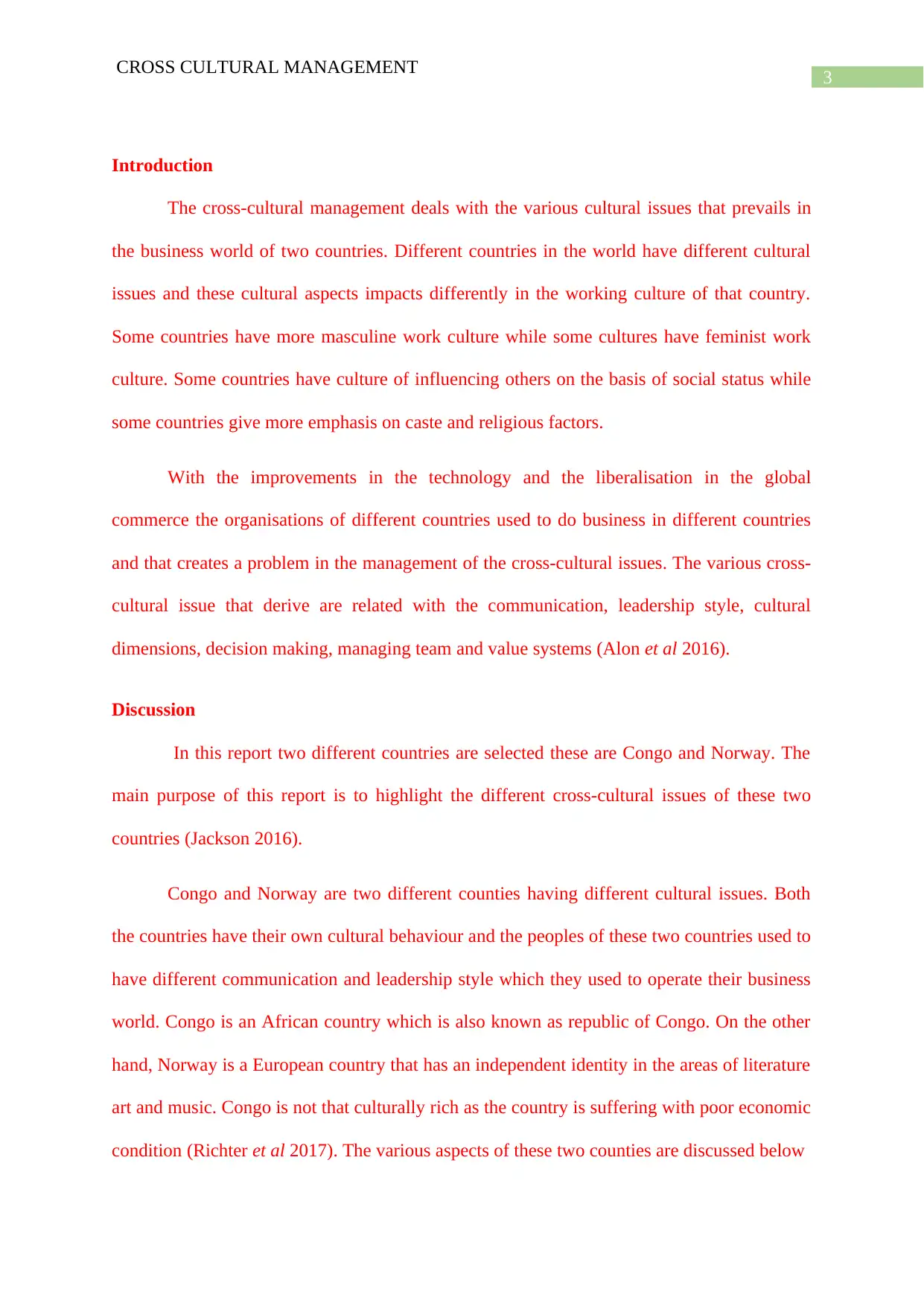
3
CROSS CULTURAL MANAGEMENT
Introduction
The cross-cultural management deals with the various cultural issues that prevails in
the business world of two countries. Different countries in the world have different cultural
issues and these cultural aspects impacts differently in the working culture of that country.
Some countries have more masculine work culture while some cultures have feminist work
culture. Some countries have culture of influencing others on the basis of social status while
some countries give more emphasis on caste and religious factors.
With the improvements in the technology and the liberalisation in the global
commerce the organisations of different countries used to do business in different countries
and that creates a problem in the management of the cross-cultural issues. The various cross-
cultural issue that derive are related with the communication, leadership style, cultural
dimensions, decision making, managing team and value systems (Alon et al 2016).
Discussion
In this report two different countries are selected these are Congo and Norway. The
main purpose of this report is to highlight the different cross-cultural issues of these two
countries (Jackson 2016).
Congo and Norway are two different counties having different cultural issues. Both
the countries have their own cultural behaviour and the peoples of these two countries used to
have different communication and leadership style which they used to operate their business
world. Congo is an African country which is also known as republic of Congo. On the other
hand, Norway is a European country that has an independent identity in the areas of literature
art and music. Congo is not that culturally rich as the country is suffering with poor economic
condition (Richter et al 2017). The various aspects of these two counties are discussed below
CROSS CULTURAL MANAGEMENT
Introduction
The cross-cultural management deals with the various cultural issues that prevails in
the business world of two countries. Different countries in the world have different cultural
issues and these cultural aspects impacts differently in the working culture of that country.
Some countries have more masculine work culture while some cultures have feminist work
culture. Some countries have culture of influencing others on the basis of social status while
some countries give more emphasis on caste and religious factors.
With the improvements in the technology and the liberalisation in the global
commerce the organisations of different countries used to do business in different countries
and that creates a problem in the management of the cross-cultural issues. The various cross-
cultural issue that derive are related with the communication, leadership style, cultural
dimensions, decision making, managing team and value systems (Alon et al 2016).
Discussion
In this report two different countries are selected these are Congo and Norway. The
main purpose of this report is to highlight the different cross-cultural issues of these two
countries (Jackson 2016).
Congo and Norway are two different counties having different cultural issues. Both
the countries have their own cultural behaviour and the peoples of these two countries used to
have different communication and leadership style which they used to operate their business
world. Congo is an African country which is also known as republic of Congo. On the other
hand, Norway is a European country that has an independent identity in the areas of literature
art and music. Congo is not that culturally rich as the country is suffering with poor economic
condition (Richter et al 2017). The various aspects of these two counties are discussed below
Paraphrase This Document
Need a fresh take? Get an instant paraphrase of this document with our AI Paraphraser
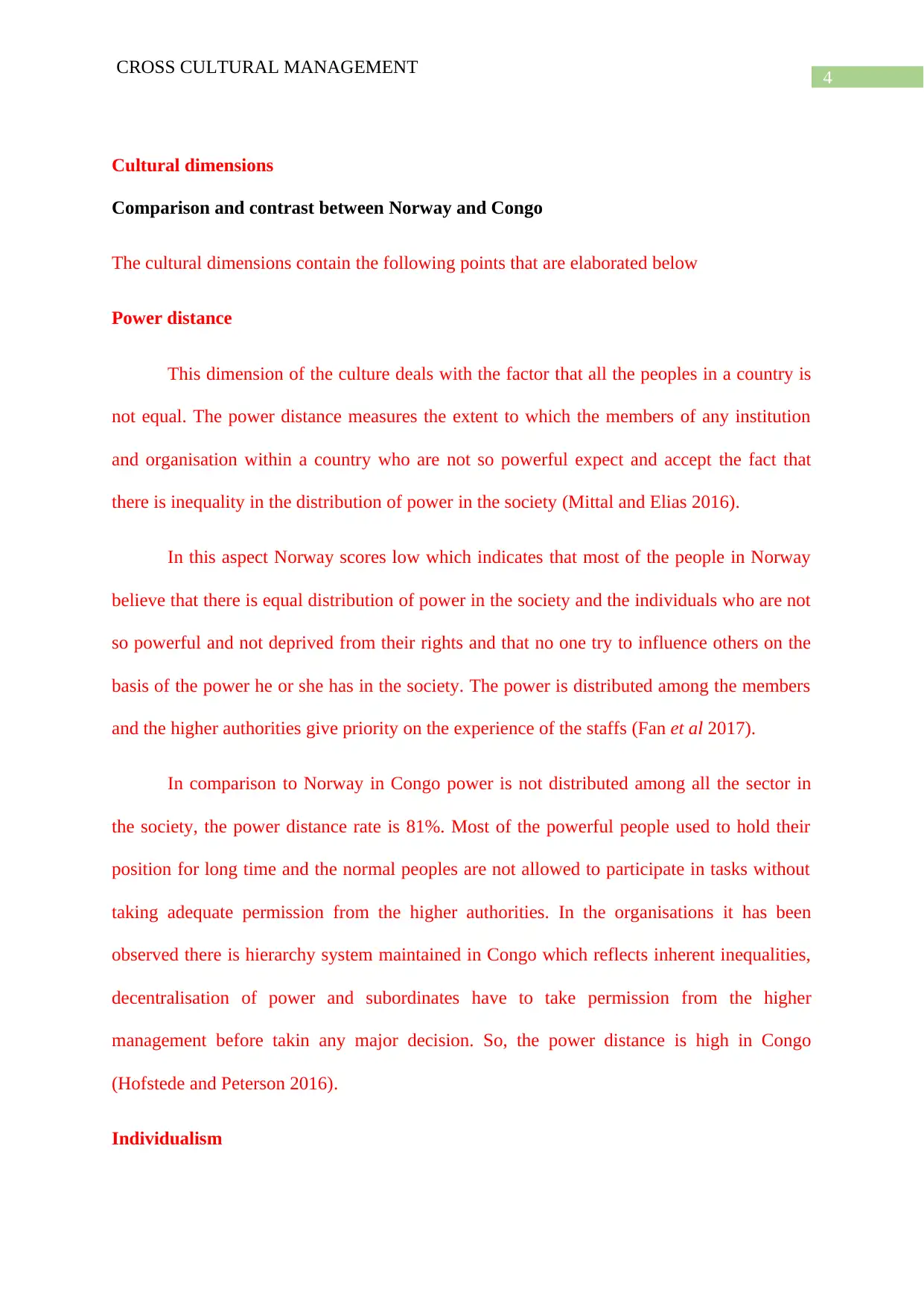
4
CROSS CULTURAL MANAGEMENT
Cultural dimensions
Comparison and contrast between Norway and Congo
The cultural dimensions contain the following points that are elaborated below
Power distance
This dimension of the culture deals with the factor that all the peoples in a country is
not equal. The power distance measures the extent to which the members of any institution
and organisation within a country who are not so powerful expect and accept the fact that
there is inequality in the distribution of power in the society (Mittal and Elias 2016).
In this aspect Norway scores low which indicates that most of the people in Norway
believe that there is equal distribution of power in the society and the individuals who are not
so powerful and not deprived from their rights and that no one try to influence others on the
basis of the power he or she has in the society. The power is distributed among the members
and the higher authorities give priority on the experience of the staffs (Fan et al 2017).
In comparison to Norway in Congo power is not distributed among all the sector in
the society, the power distance rate is 81%. Most of the powerful people used to hold their
position for long time and the normal peoples are not allowed to participate in tasks without
taking adequate permission from the higher authorities. In the organisations it has been
observed there is hierarchy system maintained in Congo which reflects inherent inequalities,
decentralisation of power and subordinates have to take permission from the higher
management before takin any major decision. So, the power distance is high in Congo
(Hofstede and Peterson 2016).
Individualism
CROSS CULTURAL MANAGEMENT
Cultural dimensions
Comparison and contrast between Norway and Congo
The cultural dimensions contain the following points that are elaborated below
Power distance
This dimension of the culture deals with the factor that all the peoples in a country is
not equal. The power distance measures the extent to which the members of any institution
and organisation within a country who are not so powerful expect and accept the fact that
there is inequality in the distribution of power in the society (Mittal and Elias 2016).
In this aspect Norway scores low which indicates that most of the people in Norway
believe that there is equal distribution of power in the society and the individuals who are not
so powerful and not deprived from their rights and that no one try to influence others on the
basis of the power he or she has in the society. The power is distributed among the members
and the higher authorities give priority on the experience of the staffs (Fan et al 2017).
In comparison to Norway in Congo power is not distributed among all the sector in
the society, the power distance rate is 81%. Most of the powerful people used to hold their
position for long time and the normal peoples are not allowed to participate in tasks without
taking adequate permission from the higher authorities. In the organisations it has been
observed there is hierarchy system maintained in Congo which reflects inherent inequalities,
decentralisation of power and subordinates have to take permission from the higher
management before takin any major decision. So, the power distance is high in Congo
(Hofstede and Peterson 2016).
Individualism
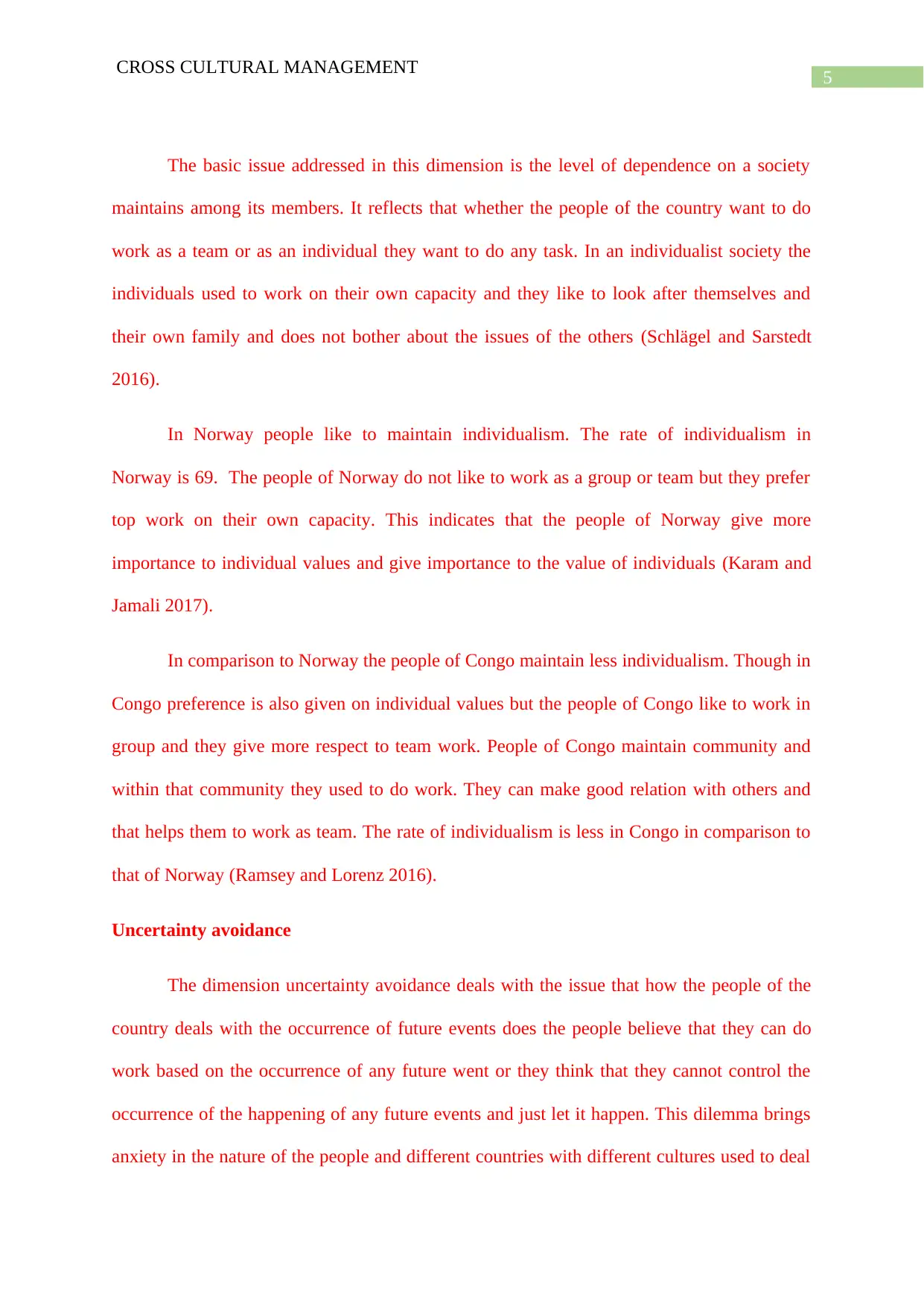
5
CROSS CULTURAL MANAGEMENT
The basic issue addressed in this dimension is the level of dependence on a society
maintains among its members. It reflects that whether the people of the country want to do
work as a team or as an individual they want to do any task. In an individualist society the
individuals used to work on their own capacity and they like to look after themselves and
their own family and does not bother about the issues of the others (Schlägel and Sarstedt
2016).
In Norway people like to maintain individualism. The rate of individualism in
Norway is 69. The people of Norway do not like to work as a group or team but they prefer
top work on their own capacity. This indicates that the people of Norway give more
importance to individual values and give importance to the value of individuals (Karam and
Jamali 2017).
In comparison to Norway the people of Congo maintain less individualism. Though in
Congo preference is also given on individual values but the people of Congo like to work in
group and they give more respect to team work. People of Congo maintain community and
within that community they used to do work. They can make good relation with others and
that helps them to work as team. The rate of individualism is less in Congo in comparison to
that of Norway (Ramsey and Lorenz 2016).
Uncertainty avoidance
The dimension uncertainty avoidance deals with the issue that how the people of the
country deals with the occurrence of future events does the people believe that they can do
work based on the occurrence of any future went or they think that they cannot control the
occurrence of the happening of any future events and just let it happen. This dilemma brings
anxiety in the nature of the people and different countries with different cultures used to deal
CROSS CULTURAL MANAGEMENT
The basic issue addressed in this dimension is the level of dependence on a society
maintains among its members. It reflects that whether the people of the country want to do
work as a team or as an individual they want to do any task. In an individualist society the
individuals used to work on their own capacity and they like to look after themselves and
their own family and does not bother about the issues of the others (Schlägel and Sarstedt
2016).
In Norway people like to maintain individualism. The rate of individualism in
Norway is 69. The people of Norway do not like to work as a group or team but they prefer
top work on their own capacity. This indicates that the people of Norway give more
importance to individual values and give importance to the value of individuals (Karam and
Jamali 2017).
In comparison to Norway the people of Congo maintain less individualism. Though in
Congo preference is also given on individual values but the people of Congo like to work in
group and they give more respect to team work. People of Congo maintain community and
within that community they used to do work. They can make good relation with others and
that helps them to work as team. The rate of individualism is less in Congo in comparison to
that of Norway (Ramsey and Lorenz 2016).
Uncertainty avoidance
The dimension uncertainty avoidance deals with the issue that how the people of the
country deals with the occurrence of future events does the people believe that they can do
work based on the occurrence of any future went or they think that they cannot control the
occurrence of the happening of any future events and just let it happen. This dilemma brings
anxiety in the nature of the people and different countries with different cultures used to deal
⊘ This is a preview!⊘
Do you want full access?
Subscribe today to unlock all pages.

Trusted by 1+ million students worldwide
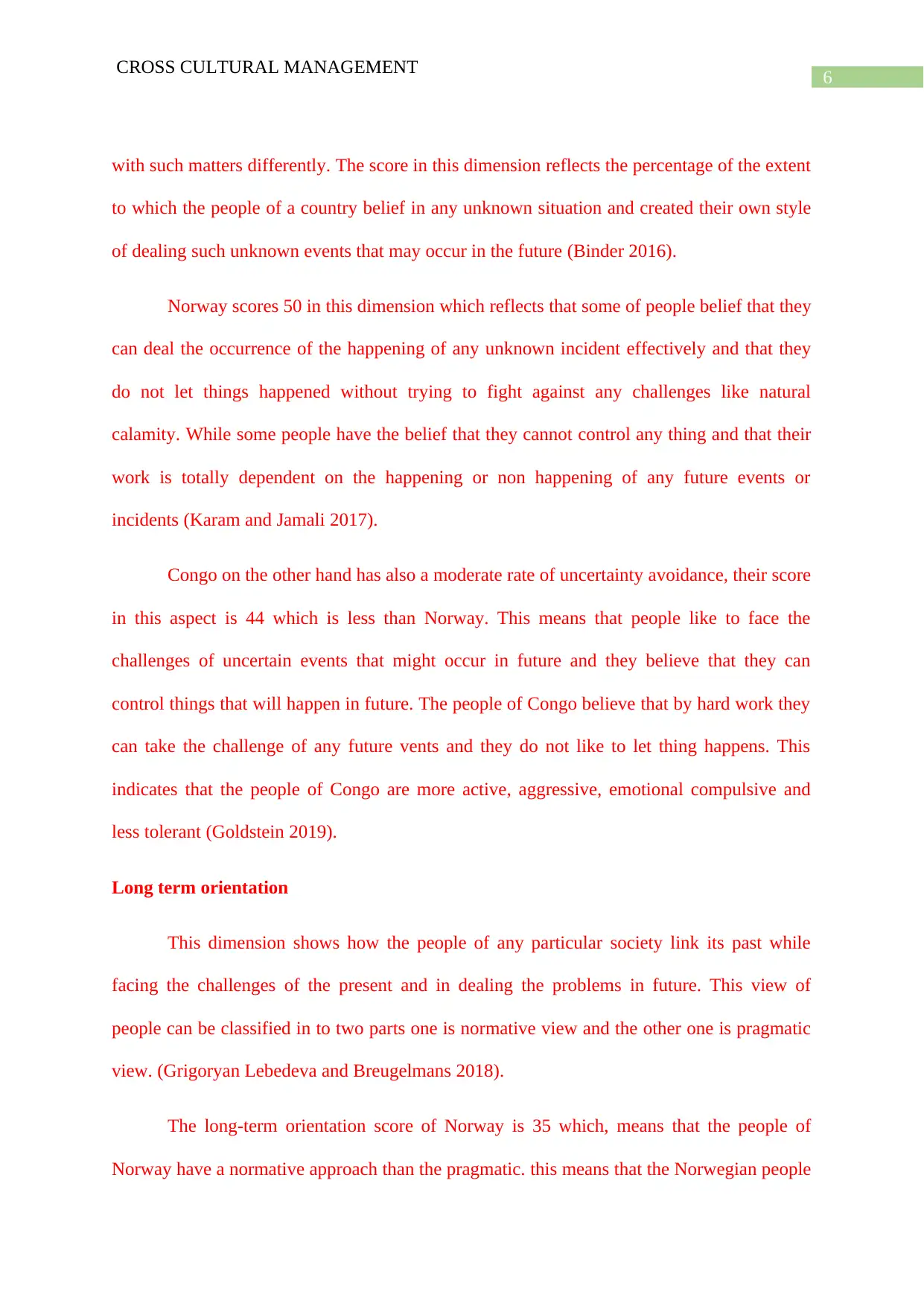
6
CROSS CULTURAL MANAGEMENT
with such matters differently. The score in this dimension reflects the percentage of the extent
to which the people of a country belief in any unknown situation and created their own style
of dealing such unknown events that may occur in the future (Binder 2016).
Norway scores 50 in this dimension which reflects that some of people belief that they
can deal the occurrence of the happening of any unknown incident effectively and that they
do not let things happened without trying to fight against any challenges like natural
calamity. While some people have the belief that they cannot control any thing and that their
work is totally dependent on the happening or non happening of any future events or
incidents (Karam and Jamali 2017).
Congo on the other hand has also a moderate rate of uncertainty avoidance, their score
in this aspect is 44 which is less than Norway. This means that people like to face the
challenges of uncertain events that might occur in future and they believe that they can
control things that will happen in future. The people of Congo believe that by hard work they
can take the challenge of any future vents and they do not like to let thing happens. This
indicates that the people of Congo are more active, aggressive, emotional compulsive and
less tolerant (Goldstein 2019).
Long term orientation
This dimension shows how the people of any particular society link its past while
facing the challenges of the present and in dealing the problems in future. This view of
people can be classified in to two parts one is normative view and the other one is pragmatic
view. (Grigoryan Lebedeva and Breugelmans 2018).
The long-term orientation score of Norway is 35 which, means that the people of
Norway have a normative approach than the pragmatic. this means that the Norwegian people
CROSS CULTURAL MANAGEMENT
with such matters differently. The score in this dimension reflects the percentage of the extent
to which the people of a country belief in any unknown situation and created their own style
of dealing such unknown events that may occur in the future (Binder 2016).
Norway scores 50 in this dimension which reflects that some of people belief that they
can deal the occurrence of the happening of any unknown incident effectively and that they
do not let things happened without trying to fight against any challenges like natural
calamity. While some people have the belief that they cannot control any thing and that their
work is totally dependent on the happening or non happening of any future events or
incidents (Karam and Jamali 2017).
Congo on the other hand has also a moderate rate of uncertainty avoidance, their score
in this aspect is 44 which is less than Norway. This means that people like to face the
challenges of uncertain events that might occur in future and they believe that they can
control things that will happen in future. The people of Congo believe that by hard work they
can take the challenge of any future vents and they do not like to let thing happens. This
indicates that the people of Congo are more active, aggressive, emotional compulsive and
less tolerant (Goldstein 2019).
Long term orientation
This dimension shows how the people of any particular society link its past while
facing the challenges of the present and in dealing the problems in future. This view of
people can be classified in to two parts one is normative view and the other one is pragmatic
view. (Grigoryan Lebedeva and Breugelmans 2018).
The long-term orientation score of Norway is 35 which, means that the people of
Norway have a normative approach than the pragmatic. this means that the Norwegian people
Paraphrase This Document
Need a fresh take? Get an instant paraphrase of this document with our AI Paraphraser
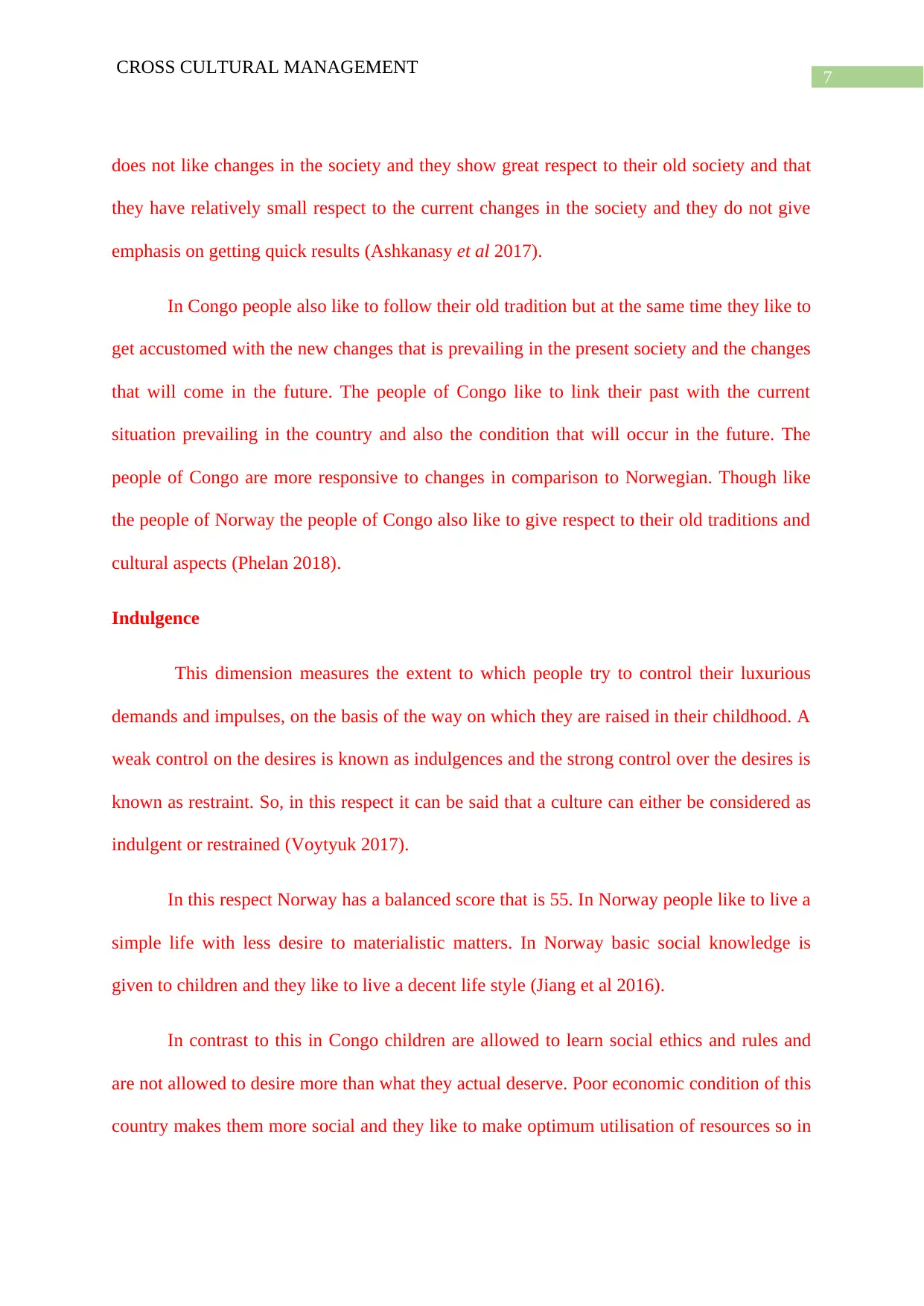
7
CROSS CULTURAL MANAGEMENT
does not like changes in the society and they show great respect to their old society and that
they have relatively small respect to the current changes in the society and they do not give
emphasis on getting quick results (Ashkanasy et al 2017).
In Congo people also like to follow their old tradition but at the same time they like to
get accustomed with the new changes that is prevailing in the present society and the changes
that will come in the future. The people of Congo like to link their past with the current
situation prevailing in the country and also the condition that will occur in the future. The
people of Congo are more responsive to changes in comparison to Norwegian. Though like
the people of Norway the people of Congo also like to give respect to their old traditions and
cultural aspects (Phelan 2018).
Indulgence
This dimension measures the extent to which people try to control their luxurious
demands and impulses, on the basis of the way on which they are raised in their childhood. A
weak control on the desires is known as indulgences and the strong control over the desires is
known as restraint. So, in this respect it can be said that a culture can either be considered as
indulgent or restrained (Voytyuk 2017).
In this respect Norway has a balanced score that is 55. In Norway people like to live a
simple life with less desire to materialistic matters. In Norway basic social knowledge is
given to children and they like to live a decent life style (Jiang et al 2016).
In contrast to this in Congo children are allowed to learn social ethics and rules and
are not allowed to desire more than what they actual deserve. Poor economic condition of this
country makes them more social and they like to make optimum utilisation of resources so in
CROSS CULTURAL MANAGEMENT
does not like changes in the society and they show great respect to their old society and that
they have relatively small respect to the current changes in the society and they do not give
emphasis on getting quick results (Ashkanasy et al 2017).
In Congo people also like to follow their old tradition but at the same time they like to
get accustomed with the new changes that is prevailing in the present society and the changes
that will come in the future. The people of Congo like to link their past with the current
situation prevailing in the country and also the condition that will occur in the future. The
people of Congo are more responsive to changes in comparison to Norwegian. Though like
the people of Norway the people of Congo also like to give respect to their old traditions and
cultural aspects (Phelan 2018).
Indulgence
This dimension measures the extent to which people try to control their luxurious
demands and impulses, on the basis of the way on which they are raised in their childhood. A
weak control on the desires is known as indulgences and the strong control over the desires is
known as restraint. So, in this respect it can be said that a culture can either be considered as
indulgent or restrained (Voytyuk 2017).
In this respect Norway has a balanced score that is 55. In Norway people like to live a
simple life with less desire to materialistic matters. In Norway basic social knowledge is
given to children and they like to live a decent life style (Jiang et al 2016).
In contrast to this in Congo children are allowed to learn social ethics and rules and
are not allowed to desire more than what they actual deserve. Poor economic condition of this
country makes them more social and they like to make optimum utilisation of resources so in
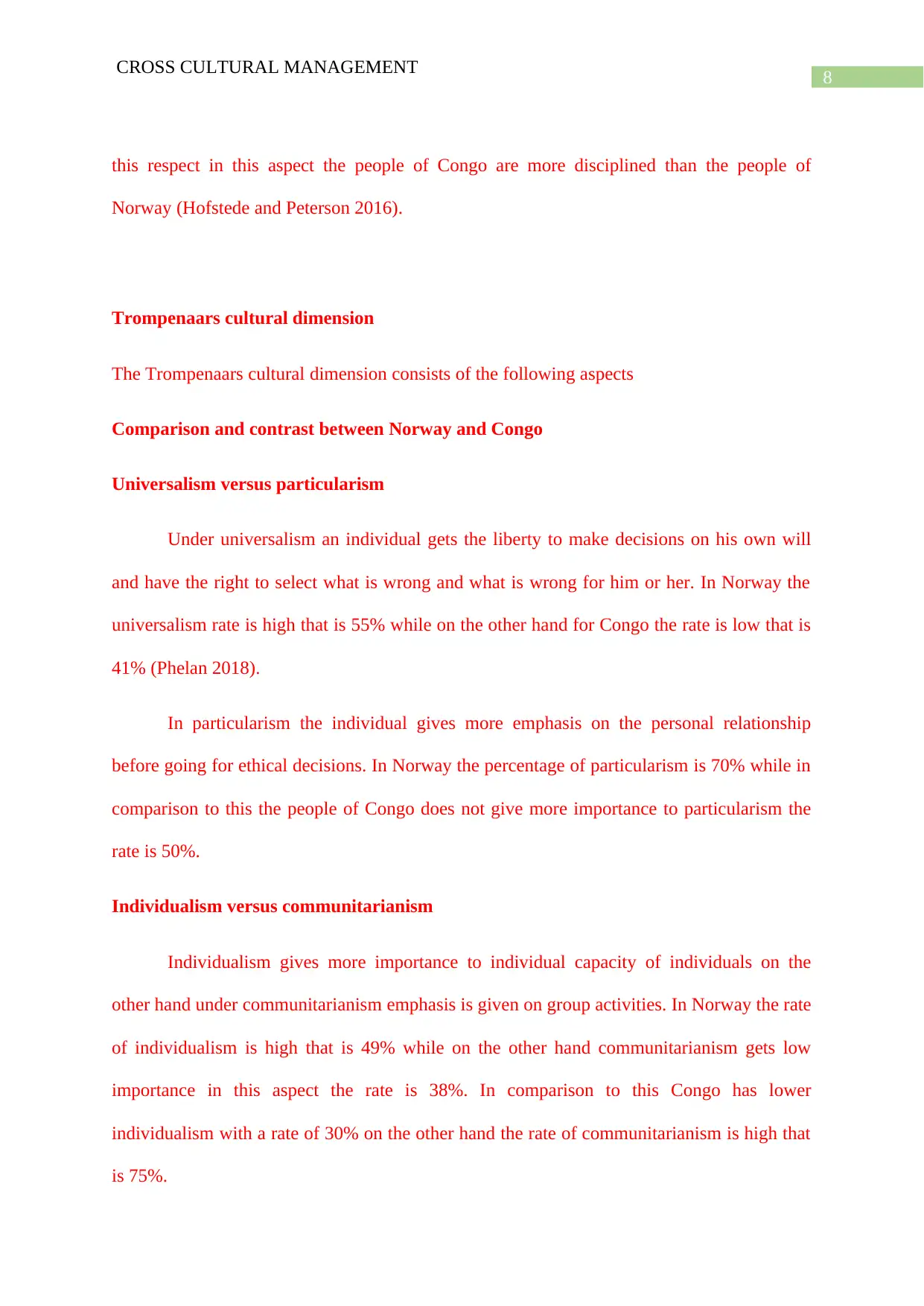
8
CROSS CULTURAL MANAGEMENT
this respect in this aspect the people of Congo are more disciplined than the people of
Norway (Hofstede and Peterson 2016).
Trompenaars cultural dimension
The Trompenaars cultural dimension consists of the following aspects
Comparison and contrast between Norway and Congo
Universalism versus particularism
Under universalism an individual gets the liberty to make decisions on his own will
and have the right to select what is wrong and what is wrong for him or her. In Norway the
universalism rate is high that is 55% while on the other hand for Congo the rate is low that is
41% (Phelan 2018).
In particularism the individual gives more emphasis on the personal relationship
before going for ethical decisions. In Norway the percentage of particularism is 70% while in
comparison to this the people of Congo does not give more importance to particularism the
rate is 50%.
Individualism versus communitarianism
Individualism gives more importance to individual capacity of individuals on the
other hand under communitarianism emphasis is given on group activities. In Norway the rate
of individualism is high that is 49% while on the other hand communitarianism gets low
importance in this aspect the rate is 38%. In comparison to this Congo has lower
individualism with a rate of 30% on the other hand the rate of communitarianism is high that
is 75%.
CROSS CULTURAL MANAGEMENT
this respect in this aspect the people of Congo are more disciplined than the people of
Norway (Hofstede and Peterson 2016).
Trompenaars cultural dimension
The Trompenaars cultural dimension consists of the following aspects
Comparison and contrast between Norway and Congo
Universalism versus particularism
Under universalism an individual gets the liberty to make decisions on his own will
and have the right to select what is wrong and what is wrong for him or her. In Norway the
universalism rate is high that is 55% while on the other hand for Congo the rate is low that is
41% (Phelan 2018).
In particularism the individual gives more emphasis on the personal relationship
before going for ethical decisions. In Norway the percentage of particularism is 70% while in
comparison to this the people of Congo does not give more importance to particularism the
rate is 50%.
Individualism versus communitarianism
Individualism gives more importance to individual capacity of individuals on the
other hand under communitarianism emphasis is given on group activities. In Norway the rate
of individualism is high that is 49% while on the other hand communitarianism gets low
importance in this aspect the rate is 38%. In comparison to this Congo has lower
individualism with a rate of 30% on the other hand the rate of communitarianism is high that
is 75%.
⊘ This is a preview!⊘
Do you want full access?
Subscribe today to unlock all pages.

Trusted by 1+ million students worldwide
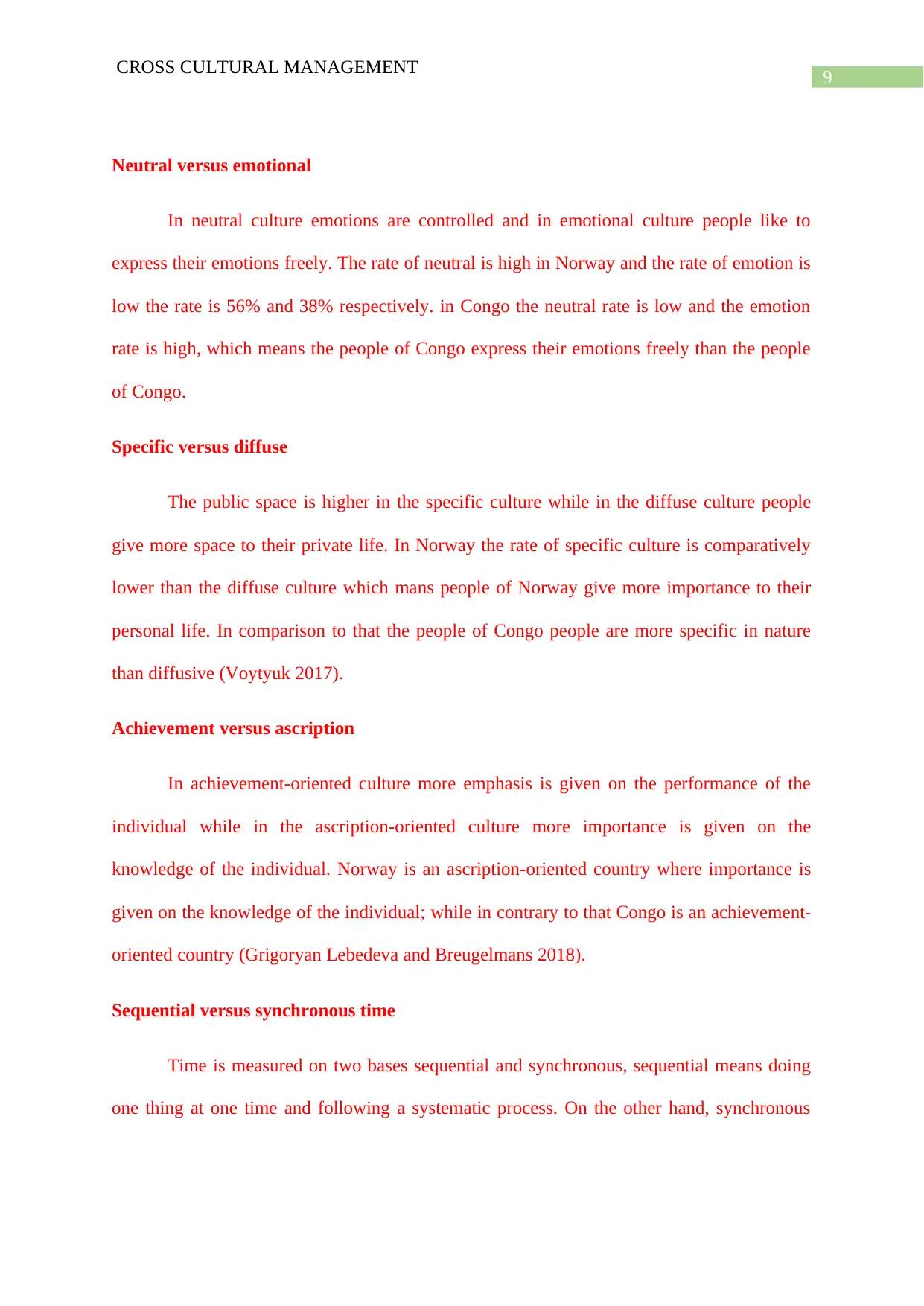
9
CROSS CULTURAL MANAGEMENT
Neutral versus emotional
In neutral culture emotions are controlled and in emotional culture people like to
express their emotions freely. The rate of neutral is high in Norway and the rate of emotion is
low the rate is 56% and 38% respectively. in Congo the neutral rate is low and the emotion
rate is high, which means the people of Congo express their emotions freely than the people
of Congo.
Specific versus diffuse
The public space is higher in the specific culture while in the diffuse culture people
give more space to their private life. In Norway the rate of specific culture is comparatively
lower than the diffuse culture which mans people of Norway give more importance to their
personal life. In comparison to that the people of Congo people are more specific in nature
than diffusive (Voytyuk 2017).
Achievement versus ascription
In achievement-oriented culture more emphasis is given on the performance of the
individual while in the ascription-oriented culture more importance is given on the
knowledge of the individual. Norway is an ascription-oriented country where importance is
given on the knowledge of the individual; while in contrary to that Congo is an achievement-
oriented country (Grigoryan Lebedeva and Breugelmans 2018).
Sequential versus synchronous time
Time is measured on two bases sequential and synchronous, sequential means doing
one thing at one time and following a systematic process. On the other hand, synchronous
CROSS CULTURAL MANAGEMENT
Neutral versus emotional
In neutral culture emotions are controlled and in emotional culture people like to
express their emotions freely. The rate of neutral is high in Norway and the rate of emotion is
low the rate is 56% and 38% respectively. in Congo the neutral rate is low and the emotion
rate is high, which means the people of Congo express their emotions freely than the people
of Congo.
Specific versus diffuse
The public space is higher in the specific culture while in the diffuse culture people
give more space to their private life. In Norway the rate of specific culture is comparatively
lower than the diffuse culture which mans people of Norway give more importance to their
personal life. In comparison to that the people of Congo people are more specific in nature
than diffusive (Voytyuk 2017).
Achievement versus ascription
In achievement-oriented culture more emphasis is given on the performance of the
individual while in the ascription-oriented culture more importance is given on the
knowledge of the individual. Norway is an ascription-oriented country where importance is
given on the knowledge of the individual; while in contrary to that Congo is an achievement-
oriented country (Grigoryan Lebedeva and Breugelmans 2018).
Sequential versus synchronous time
Time is measured on two bases sequential and synchronous, sequential means doing
one thing at one time and following a systematic process. On the other hand, synchronous
Paraphrase This Document
Need a fresh take? Get an instant paraphrase of this document with our AI Paraphraser
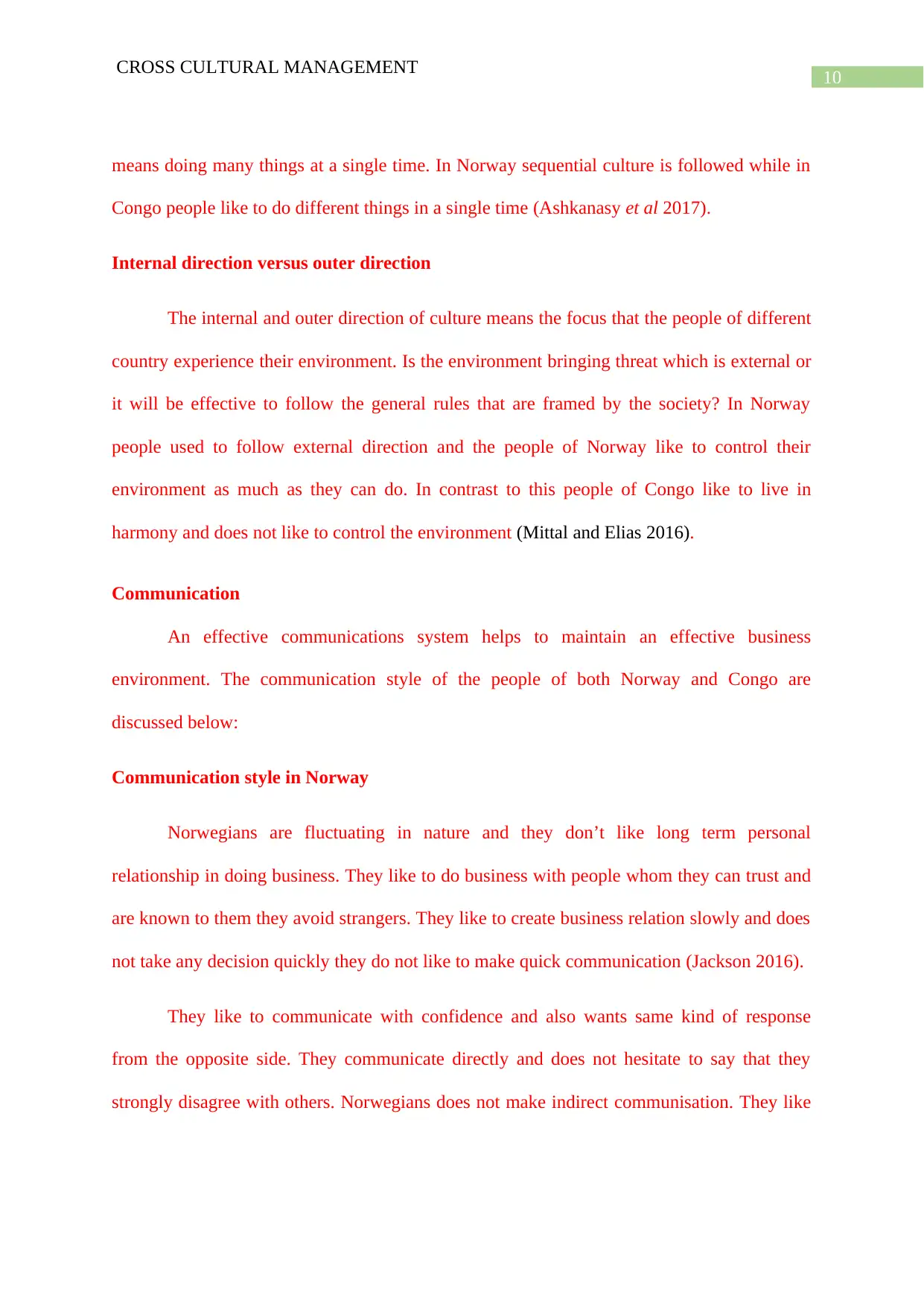
10
CROSS CULTURAL MANAGEMENT
means doing many things at a single time. In Norway sequential culture is followed while in
Congo people like to do different things in a single time (Ashkanasy et al 2017).
Internal direction versus outer direction
The internal and outer direction of culture means the focus that the people of different
country experience their environment. Is the environment bringing threat which is external or
it will be effective to follow the general rules that are framed by the society? In Norway
people used to follow external direction and the people of Norway like to control their
environment as much as they can do. In contrast to this people of Congo like to live in
harmony and does not like to control the environment (Mittal and Elias 2016).
Communication
An effective communications system helps to maintain an effective business
environment. The communication style of the people of both Norway and Congo are
discussed below:
Communication style in Norway
Norwegians are fluctuating in nature and they don’t like long term personal
relationship in doing business. They like to do business with people whom they can trust and
are known to them they avoid strangers. They like to create business relation slowly and does
not take any decision quickly they do not like to make quick communication (Jackson 2016).
They like to communicate with confidence and also wants same kind of response
from the opposite side. They communicate directly and does not hesitate to say that they
strongly disagree with others. Norwegians does not make indirect communisation. They like
CROSS CULTURAL MANAGEMENT
means doing many things at a single time. In Norway sequential culture is followed while in
Congo people like to do different things in a single time (Ashkanasy et al 2017).
Internal direction versus outer direction
The internal and outer direction of culture means the focus that the people of different
country experience their environment. Is the environment bringing threat which is external or
it will be effective to follow the general rules that are framed by the society? In Norway
people used to follow external direction and the people of Norway like to control their
environment as much as they can do. In contrast to this people of Congo like to live in
harmony and does not like to control the environment (Mittal and Elias 2016).
Communication
An effective communications system helps to maintain an effective business
environment. The communication style of the people of both Norway and Congo are
discussed below:
Communication style in Norway
Norwegians are fluctuating in nature and they don’t like long term personal
relationship in doing business. They like to do business with people whom they can trust and
are known to them they avoid strangers. They like to create business relation slowly and does
not take any decision quickly they do not like to make quick communication (Jackson 2016).
They like to communicate with confidence and also wants same kind of response
from the opposite side. They communicate directly and does not hesitate to say that they
strongly disagree with others. Norwegians does not make indirect communisation. They like
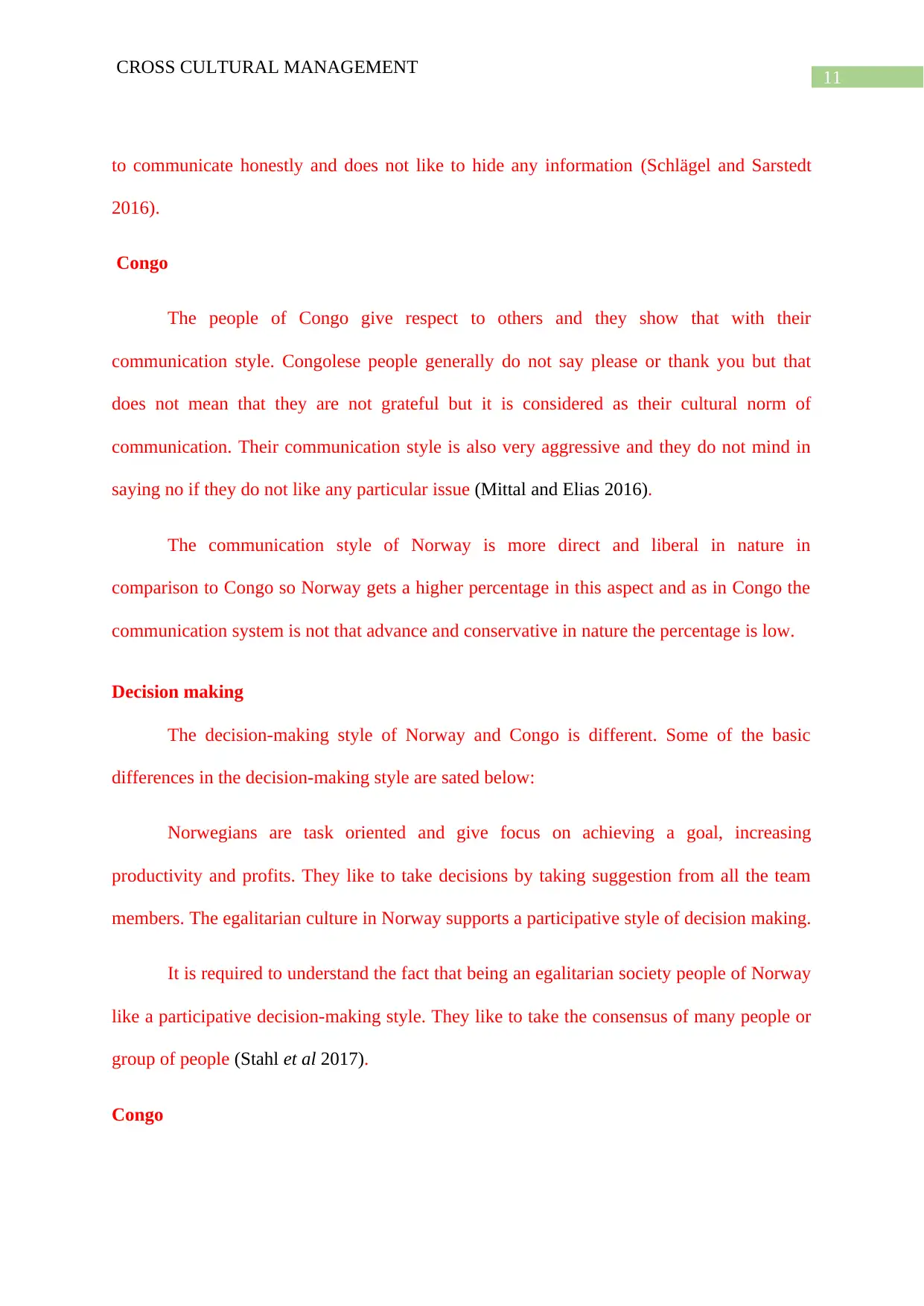
11
CROSS CULTURAL MANAGEMENT
to communicate honestly and does not like to hide any information (Schlägel and Sarstedt
2016).
Congo
The people of Congo give respect to others and they show that with their
communication style. Congolese people generally do not say please or thank you but that
does not mean that they are not grateful but it is considered as their cultural norm of
communication. Their communication style is also very aggressive and they do not mind in
saying no if they do not like any particular issue (Mittal and Elias 2016).
The communication style of Norway is more direct and liberal in nature in
comparison to Congo so Norway gets a higher percentage in this aspect and as in Congo the
communication system is not that advance and conservative in nature the percentage is low.
Decision making
The decision-making style of Norway and Congo is different. Some of the basic
differences in the decision-making style are sated below:
Norwegians are task oriented and give focus on achieving a goal, increasing
productivity and profits. They like to take decisions by taking suggestion from all the team
members. The egalitarian culture in Norway supports a participative style of decision making.
It is required to understand the fact that being an egalitarian society people of Norway
like a participative decision-making style. They like to take the consensus of many people or
group of people (Stahl et al 2017).
Congo
CROSS CULTURAL MANAGEMENT
to communicate honestly and does not like to hide any information (Schlägel and Sarstedt
2016).
Congo
The people of Congo give respect to others and they show that with their
communication style. Congolese people generally do not say please or thank you but that
does not mean that they are not grateful but it is considered as their cultural norm of
communication. Their communication style is also very aggressive and they do not mind in
saying no if they do not like any particular issue (Mittal and Elias 2016).
The communication style of Norway is more direct and liberal in nature in
comparison to Congo so Norway gets a higher percentage in this aspect and as in Congo the
communication system is not that advance and conservative in nature the percentage is low.
Decision making
The decision-making style of Norway and Congo is different. Some of the basic
differences in the decision-making style are sated below:
Norwegians are task oriented and give focus on achieving a goal, increasing
productivity and profits. They like to take decisions by taking suggestion from all the team
members. The egalitarian culture in Norway supports a participative style of decision making.
It is required to understand the fact that being an egalitarian society people of Norway
like a participative decision-making style. They like to take the consensus of many people or
group of people (Stahl et al 2017).
Congo
⊘ This is a preview!⊘
Do you want full access?
Subscribe today to unlock all pages.

Trusted by 1+ million students worldwide
1 out of 20
Related Documents
Your All-in-One AI-Powered Toolkit for Academic Success.
+13062052269
info@desklib.com
Available 24*7 on WhatsApp / Email
![[object Object]](/_next/static/media/star-bottom.7253800d.svg)
Unlock your academic potential
Copyright © 2020–2025 A2Z Services. All Rights Reserved. Developed and managed by ZUCOL.




